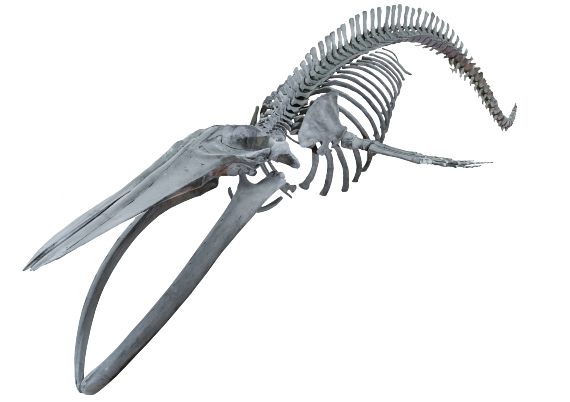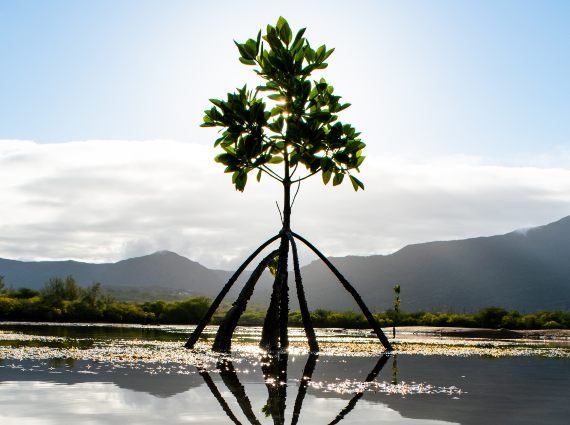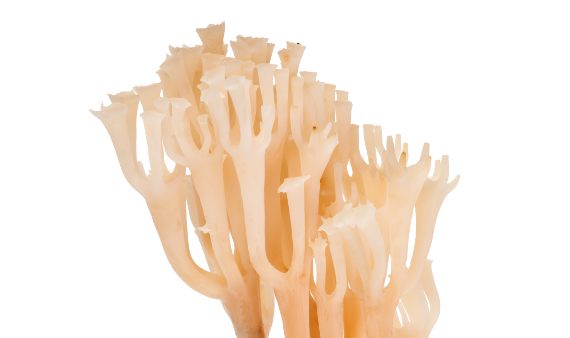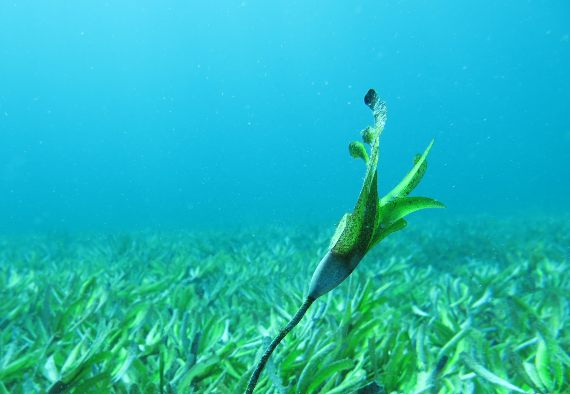An interview with Rocio Jimenez, Postdoctoral Research Scientist, Department of Biology, Cádiz University
Why are we talking about carbon neutrality, what is it and why are we raising this issue now?
By the end of the last century we had lost half of the oceans’ wealth of life. What we now call blue natural capital, which underpins the entire functioning of marine ecosystems, was being destroyed by leaps and bounds. This destruction is not only a loss of ocean life biodiversity, but has also been one of the drivers of climate change. For example, 38% of the greenhouse gases in the atmosphere come from the destruction and alteration of terrestrial and marine ecosystems caused by all the anthropogenic activities of the last century.
The whaling industry is a very clear example of this. Today there is a 10% decrease in the populations with respect to their past numbers. Whales were not only hunted for food, but they were literally hunted to be burned because their oil was highly coveted. In fact, their oil was used to light many cities in North America and Europe for more than a century. The bodies of whales, when they die, are buried at the bottom of the ocean. And that is carbon. Carbon in the end is what forms us, what forms life, in the sea and on land. And when these bodies were burned, all that carbon was released back into the atmosphere. And so on, all the way up to today’s industrial activities.

It was at the United Nations Conference in Rio de Janeiro in 2012 when the issue of the ocean as natural capital arose, that is, the search for solutions to this destruction or to these problems of the planet in nature. Small actions such as reducing emissions by using the car less or using public transport more are very good and necessary, but they are not enough. Since this summit, the ocean has been considered as natural capital, as a structural element of the world economy. Therefore, we must not only know biodiversity, but also understand the services and functions that ecosystems, in this case marine ecosystems, provide, both to the planet and to human beings. This conference was an essential turning point in environmental and social policies and challenges, because the need to find a sustainable and inclusive economic development model was recognized for the first time by all the knowledge stakeholders, not only from the scientific community, but also from politicians, managers and even companies. And at the global level, it was realized that the ocean holds 3,500 years of evolution and can provide answers to the problems facing our planet today.
This is how these nature-based climate action strategies, including blue carbon, came about. These actions are very effective because they consist of decarbonizing the atmosphere as a way to recarbonize the biosphere, all this part that we are destroying.
What exactly is blue carbon?
Blue carbon is a term that was coined in 2009. The blue carbon strategy has been growing and has an increasingly relevant role in climate action issues.
Blue carbon is all the carbon that comes from life in the ocean. That is, the carbon that is stored in coastal and marine ecosystems, including habitats, species and even processes that facilitate the absorption of this atmospheric carbon in the ocean and are transported to sediments and deep waters. A very clear example is the primary producers that photosynthesize. They take up carbon dioxide and give us oxygen. Then when they take that carbon dioxide, and use that carbon to build their bodies, to build life. And when their bodies die, some of the carbon is consumed by the food chain and goes back into the atmosphere through respiration, but a lot of it is sequestered or stored in the ocean and through the currents it reaches the deep ocean and gets stored there. This is the blue carbon.
How is climate change affecting the ocean and marine ecosystems?
The ocean faces many threats today. When we talk about climate change, there are many variables that have an influence: global warming, acidification or overfishing. All these variables influence, through a series of processes, the reduction of blue carbon stocks.
For example, in the last 60 to 70 years, the atmosphere has received 2/3 of greenhouse gases since the Industrial Revolution. Considering that 83% of the carbon cycle is in the ocean, most of this contribution comes mainly from the destruction of the functions and goods and services provided by this natural capital. All the alterations that come from climate change (and most of them come from anthropogenic actions) are reducing the ocean’s capacity to store carbon. We are releasing that carbon that should be sequestered in the ocean, we are returning it to the atmosphere, and it is contributing to the greenhouse effect that we are suffering from climate change.

This can be seen very well in coastal ecosystems, which are the great forgotten ones. As I was saying, 83% of the global carbon cycle takes place in the oceans. And half of all this carbon that is stored in the ocean is found in coastal ecosystems.
When we talk about the ocean, everyone thinks of the deep ocean, huge bodies of water, with lots of depth, whales and sharks, but coastal ecosystems, even though they only cover 2% of the entire ocean surface, are the big heroes in storing blue carbon.
Are there marine plant species that are more “efficient” at absorbing carbon?
Coastal ecosystems are made up of diverse habitats. The main ones are salt marshes, mangroves and seagrasses (or seagrass meadows). In general, mangroves or coral reefs are much better known than seagrasses, which are large submerged forests, and one of the ecosystems that have been called “heroes” in blue carbon contribution, but are still largely unknown.
Seagrasses, globally, only occupy 0.1% of the entire ocean surface, but they remove ⅓ of all the carbon that is sequestered annually on the seafloor. In other words, their contribution is very, very important.
In science, seagrasses have also been largely uncharted waters. It was only 7 years ago that a paper was published in which the first seagrass genome was sequenced. That is a very short time. It happened to these plants (they are plants, not algae because they have roots, seeds, leaves and flowers) as it happened to dolphins, which used to live on land and gradually adapted to the marine environment. When the genome of these prairies was sequenced, the incredible adaptation that these plants underwent to colonize the ocean became evident, and it was then that it was understood why there are only 60 species compared to the more than 300,000 species that exist in the terrestrial environment.

And why do these seagrasses store so much carbon? These seagrasses grow by extending their rhizome, which is like a small trunk that is under the sediment, like a subway stem, and slowly elongates. These plants grow very slowly, at a rate of between 1 and 5 centimeters per year, and branch out throughout the seafloor forming large clones.
Their leaves (which we call canopy) grow upwards in the water column in order to have enough light for photosynthesis. This canopy is very extensive and very dense and they form very productive ecosystems, generating a lot of oxygen in the system and promoting a lot of carbon. If they produce a lot of oxygen this means that they are sequestering a lot of carbon through photosynthesis. And much of this carbon is sequestered in the marine subsoil, especially through those rhizomes, those roots that are very difficult to decompose. They stay there when the tissue is dying, they just stay buried in that sediment. So all that extensive canopy, all that density of leaves, also forms a network that dissipates the energy of the currents. In other words, the marine currents, when they collide with these forests, slow down and therefore filter suspended carbon particles from other organisms that also precipitate in the marine subsoil. These particles decompose very slowly because their sediment becomes quite anoxic as the depth of the sediment increases, i.e., there is less and less oxygen and that slows down the microbial decomposition of carbon. Therefore, that carbon accumulates and is preserved for thousands of years in these ecosystems.
What is the current situation of seagrass meadows?
Climate change is affecting them a lot. We have lost a large area of seagrass around the world. It mostly started in the 1930s, with the so-called wasting disease, which was a brutal influx of sewage and agricultural runoff into the coastal system, caused by the population growth that took place and caused a huge mortality of these seagrasses along the coasts of the entire planet. And this is further aggravated by other damages that they suffer especially by the dragging of anchors or dredging of the coast, which make a plowing action of all these habitats and are eliminating all these marine plants. And not only are they destroying the populations but they are removing and suspending all that sediment that is storing the carbon and it is being emitted back into the atmosphere. In the last 10 to 20 years it is estimated that we have lost a third of the known areas of seagrasses worldwide, although there is still a lot to be discovered, because they are largely unknown ecosystems.
Can these meadows be repopulated or reforested?
These plants grow at a very, very slow rate and their reproduction is practically clonal. They have very little sexual reproduction. This means that, apart from the fact that their growth is slow, there is little success when trying to repopulate. Repopulation activities are being carried out, some with very positive results, but it is true that efforts should focus more on preserving what there is. When it comes to restoring these ecosystems, the problem is that we need seeds, because with adult shoots success is not so guaranteed. To take these seeds we have to destroy a meadow that already exists in order to repopulate others, so these are complicated actions.

Efforts should therefore be directed towards conservation. Policies are currently being implemented to protect and conserve seagrass meadows and, above all, to improve the water quality of these habitats. The results are quite encouraging, as the last two decades have seen a rebound in the expansion of these populations that have been under protection after almost a century of sustained decline. That is why we must continue working on the conservation and recovery of these grasslands and, above all, focus on protecting and conserving what is already there.
There are projects underway that are betting on “less natural” interventions in the ocean such as cultivating seaweed and sinking it in the sea to enhance carbon absorption and storage or introducing minerals into the sea to retain more CO2. What do you think about these solutions?
All these solutions are still under scientific debate as we cannot control all the variables that occur in an ecosystem such as the ocean.
For example, on the coast, there are companies that inject part of the CO2 they emit into the subsoil, into the sediments of the seagrass beds, which are not yet saturated to capacity. The problem here is that they only look at the capacity of these plants, but what about the fauna there? In the end you are acidifying a sediment, and this affects the bacterial community as well. You can generate an unwanted domino effect.
Nature is much wiser than we are, and that’s why I think efforts have to focus on protecting and conserving what’s there, and doing science, really understanding how ecosystems work, because we really don’t know everything yet.
What is the blue carbon market and what role can it play in environmental conservation?
Environmental action, the achievement of solutions for the planet, will only come when it occupies a central role in our society. Until now, it has been relegated to the scientific sphere and to purely voluntary contributions by individuals and companies. However, environmental action must become an engine of the economy that can generate quality jobs, for example. It should not only be an ethical commitment from the population or companies.
This gave rise to the idea of the blue carbon market, which had its beginnings in the United States, with the Verra Protocol, in which companies made voluntary commitments to invest in environmental actions. The problem was that this system was not regulated, which meant that companies could make commitments and then fail to comply with these agreements and nothing would happen.
In Europe, this has begun to be done in a regulated manner with the help of the administrations, with a protocol of this blue carbon standard, giving rise to the first blue carbon market in the Eurozone. And the International Union for Conservation of Nature (IUCN) has focused on the Cadiz marshes as an ecosystem to develop this project.
This choice is not accidental since the marshes of the Bay of Cadiz is a unique ecological space that has been shaped by man, by the use of salt marshes and estuaries, since the time of the Phoenicians. The problem of these ecosystems is that they are very degraded, the marshes are very abandoned. Therefore, creating private investment plans and actions to restore and preserve all these marshes, in a regulated manner and following a standard in these blue carbon bonds, can be one of the solutions to introduce this environmental action in the economy.
Comments on this publication